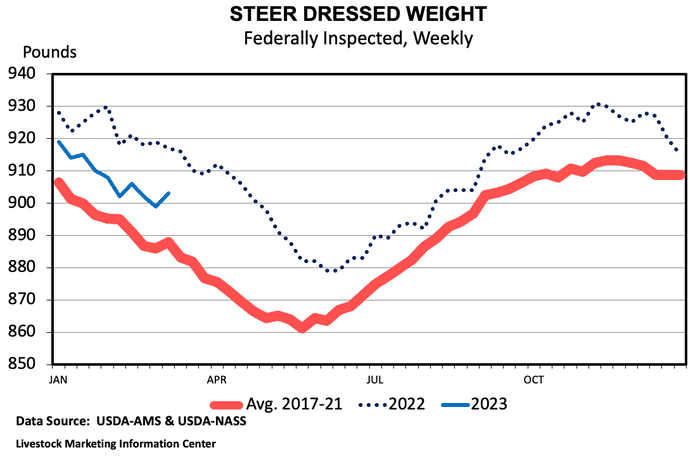Beef cow, heifer, and steer cattle slaughter
Smaller calf crops over the past few years mean there are fewer steers moving through feedlots.
March 29, 2023

Weekly cattle slaughter began 2023 trending lower than a year ago. Beef cow slaughter, heifer slaughter, and steer slaughter have each begun 2023 with lower slaughter totals than in 2022.

The recent decline in beef cow slaughter is perhaps the most interesting given the large cow slaughter totals seen in 2022. Drought and higher input costs relative to calf prices lead to really high beef cow slaughter in 2022 (about 11 percent above 2023). However, beef cow slaughter has moderated to begin 2023 as shown in the chart above.
Over the first 10 weeks of 2023, beef cow slaughter totaled 683,700 head which is nearly 9 percent below the first 10 weeks of 2022. Improved drought conditions in many parts of the U.S. and optimism about calf prices are key contributors to fewer cows going to market than a year ago. It is worth noting that beef cow slaughter typically declines seasonally during the first few months of the year.
Heifer slaughter has also flipped to a slight decline after large totals in 2022. Heifer slaughter totaled 1.96 million head through the first 10 weeks of 2023 which is about 0.5 percent lower than the same period of 2022. However, this is an important shift from the larger totals seen in 2022. Heifer slaughter in 2022 was about 5 percent higher than in 2022. The reasons for higher heifer slaughter in 2022 were similar to beef cows: drought and input costs relative to expected returns from retaining heifers for breeding purposes.
Steer slaughter was 3.5 percent lower over the first 10 weeks of 2023 compared to the same period in 2022. Through the week of March 11th, 2.88 million head of steers were processed which is down from 2.99 million head to start 2022. Shown in the first chart below, steer slaughter was not elevated above average levels in 2022 like beef cow and heifer slaughter totals were.
Steer slaughter in 2022 was about 2 percent lower than in 2021. Smaller calf crops over the past few years mean there are fewer steers moving through feedlots and that trend is expected to continue in 2023. Also interesting is the lower steer dressed weights (shown in the second chart below) as feedlots become increasingly current. Fewer steers slaughtered and lower dressed weights are key drivers to the expectation of lower beef production in 2023.


You May Also Like


.png?width=300&auto=webp&quality=80&disable=upscale)
